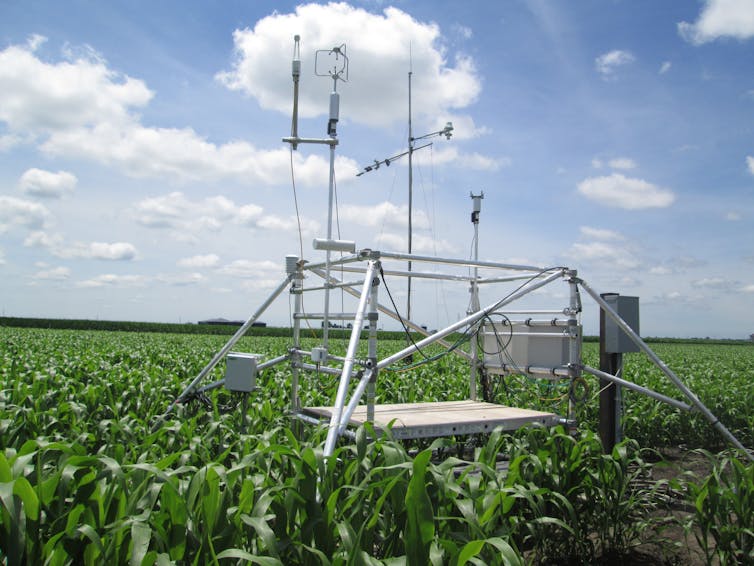
Carbon dioxide feeds plants, but are earth’s plants getting full?
If a major new study is right, then even our most cautious climate projections have likely been optimistic.
Dec. 10, 2020 • 6 min • Source
Plants do a lot of work for us, producing the air we breathe, the food we eat, and even some of our medicine. But when it comes to removing carbon dioxide in the atmosphere, we may have been overestimating their ability.
Photosynthesis acts as the lungs of our planet – plants use light and carbon dioxide (CO₂) to make the sugars they need to grow, releasing oxygen in the process. When atmospheric CO₂ concentrations increase, as they have been thanks to humans burning fossil fuels, one might think that plants are enjoying a smorgasbord of food for unlimited growth. But a new study published in Science shows this excess of riches is not as effective as previously thought.
Since CO₂ is the main source of food for plants, increasing levels of it directly stimulate the photosynthetic rate of most plants. This boost in photosynthesis , known as the “CO₂ fertilisation effect”, enhances growth in many of earth’s plant species, with the effects seen most clearly in crops and young trees, and less so in mature forests .
The amount of CO₂ used by photosynthesis and stored in vegetation and soils has grown over the past 50 years , and now absorbs at least a quarter of human emissions in an average year. We’ve been assuming that this benefit will continue to increase as CO₂ concentrations rise, but data collected over a 33-year period show us that might not be true.
Fertilisation is in decline
Estimating the size of the global CO₂-fertilisation effect accurately is no easy task. We have to understand what limits photosynthesis from one region to another, and at every scale from molecules within a leaf through to whole ecosystems.
The big research team behind the new Science study used a combination of data from satellites and on-the-ground observations and models of the carbon cycle. Using this powerful toolkit, they found that the fertilisation effect declined across much of the globe from 1982 to 2015 – a trend that correlates well with observed changes in nutrient concentrations and available soil water .
In many ways, the combination of these different tools helps to paint a more complete picture of how the world’s ecosystems are photosynthesising. The researchers used a collection of long-term measurements from flux towers like the one pictured below which continuously monitor the CO₂ and water used by plants and are dotted across earth’s biomes and provide the best means of measuring photosynthesis at the ecosystem scale.

Flux towers are limited in their measurement range (1 km or so) – but the data these towers collect helps verify the satellite estimates of how much photosynthesis is going on. With satellites and flux towers now providing records since the 1990s (and earlier in some cases), scientists are able to assess long-term trends in global photosynthesis. These can then be compared to “models” – the computer-based simulations predicting plant–environment interactions – as the researchers did in this recent study.
What might the models be missing?
Researchers in the latest study found that the decrease in CO₂ fertilisation was related to the availability of nutrients and water, which the computer simulations might not be accounting for properly. We know that nutrients such as nitrogen and phosphorus are declining ) in some areas – which may be unaccounted for. Plants can also acclimate, or change how they grow, when the environment changes.
Just like we can spend less on groceries when food is plentiful, plants invest less nitrogen in photosynthesis when they are grown at high CO₂. When this happens, CO₂ fertilisation is less effective than before. Because some plants have a stronger response than others, the response can be difficult to account for in computer simulations.
For many years, some people have assumed that carbon fertilisation will mitigate climate change by slowing the rate at which CO₂ is increasing in the atmosphere. Although the effect is built into the models used to predict future climates, the argument has become widely misinterpreted by those who believe the world is overreacting to climate change.
But if the new study is right, and we have indeed been overestimating the amount of carbon that plants will pull from the atmosphere in the future, even our most cautious climate projections have likely been optimistic.
Amanda Cavanagh receives funding from Realizing Increased Photosynthetic Efficiency (RIPE), an international research project that is engineering crops to photosynthesize more efficiently to sustainably increase worldwide food productivity with support from the Bill & Melinda Gates Foundation, the Foundation for Food and Agriculture Research (FFAR), and the U.K. Foreign, Commonwealth and Development Office (FCDO)
Caitlin Moore does not work for, consult, own shares in or receive funding from any company or organization that would benefit from this article, and has disclosed no relevant affiliations beyond their academic appointment.


